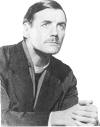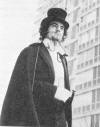The University Revues
a) The 'Oxbridge mafia'
Oxford and Cambridge both have a long tradition of
revues, but probably is it even stronger in Cambridge than in Oxford.
An event of significant importance was the creation in 1883 of the
Cambridge University Footlight Club. The first shows were in the form
of musical comedies, but in 1919, the first revue appeared, called
"Reconstruction".
Membership was limited to men and therefore, female
impersonation became a necessary art, at least until 1932 when women
were included in the cast for the first time. But the result was such
a disaster that the next revue was called "No More Women", and since
then women seldom performed in the revues.
Up to the 1960's, the club was rather élitist and
new members had to be proposed by existing members and would be
invited to perform at an audition. Only those thought to be suitable
would be allowed to join. At the end of each university year, the
actual Footlights revue would be mounted for a two-week run, in the
Arts Theatre at Cambridge and would usually tour in Oxford and
eventually be presented as one of the unofficial entertainments
mounted on the 'fringe' of the Edinburgh Arts Festival in August. Then
the performers would separate to take up their intended careers or
continue in comedy and indeed many of them became famous comedians.
Oxford also had a tradition of revues and smoking
concerts and - though Cambridge always seemed to be more in the
limelight - Oxford produced very talented comedians like Alan Bennett
for instance. In Oxford the two major organizations were the Oxford
University Dramatic Society and the Experimental Theatre Club, but the
real counterpart of the Footlight Club in Cambridge appeared when
Bennett, together with Dudley Moore, Jonathan Miller and Peter Cook,
all of them studying in Oxford assembled to create the revue Beyond
the Fringe. The show was performed in Edinburgh and then went to
London, Cambridge, Brighton and was on the whole a real critical
success. The revue was in a satirical tone even if - like the Pythons
later - none of the writers had an indignant nor anarchic approach to
the world. This is something particular to this generation of
comedians, the 'Oxbridge Mafia', educated either in Oxford or
Cambridge, coming from middle-class families and having nothing really
to complain of.
All the members of Monty Python, with the sole
exception of the American Terry Gilliam, were educated either in
Oxford or Cambridge and they all belonged to this generation of
student performers referred to as the 'Oxbridge Mafia'.
John Marwood Cleese the eldest Python was born on
27. October 1939, at Weston-Super-Mare. He was tall even as a child
and he claims that he developed his sense of humour to fend off any
teasing by his classmates. He spent five years, from 1953 to 1958, at
Clifton College, getting A levels in Physics, maths, and chemistry. He
then taught at his old preparatory school for two years while waiting
to go to Cambridge's Downing College. There he began studying law, but
was invited to join the Footlights his very first year there, thus
putting an end to his parents' dreams of him becoming a sollicitor.
|

|
|
John
Cleese |
Graham Chapman was born in Leicester on 8. January
1941. A policeman's son, he initially decided on a career in medicine.
|

|
|
Graham
Chapman. |
It was, however, his love of comedy and his
admiration of the Cambridge Footlights Society that led him to study
medicine at Emmanuel College, Cambridge, even if his ambitions were,
at least at first, rather modest. He wrote in his autobiography :
"I was glad that while waiting for written confirmation, I
had been accepted by two London teaching hospitals - more realistic
goals for a Melton Mowbray Grammar-School oik."
Even if he kept up his medical studies and eventually indeed became a
doctor, he was invited to join the Footlights at the same time as John
Cleese, after mounting his own cabaret.
As for Eric Idle, he was born at Harton Hospital,
South Shields on 29. March 1943. He lived in Oldham and Wallasey
before being sent to boarding school in 1952. Deciding to major in
English, he went to Pembroke College, Cambridge in 1962 and was voted
into the Footlights. Two years later, he was elected president of the
Footlight Club.
|

|
|
Eric
Idle |
On the other hand Terry Jones and Michael Palin
were educated in Oxford. Born on February 1, 1942, at Colwyn Bay,
North Wales, Terry Jones attended the Royal Grammar School in
Guilford. Studying history, he went to St Edmund Hall, Oxford in 1961.
He was finally attracted to the theatre scene and began acting in
various revues at the Edinburgh Festival.
|
 |

|
|
Michael Palin... |
...and Terry Jones as Mystico. |
Michael Palin, the son of an engineer, was born on
5. May 1943, in Sheffield, Yorkshire. He began attending Birkdale
Preparatory School in 1948, where he made his first dramatic
appearance as Martha Cratchit in A Christmas Carol and fell off
the stage. In 1957 he attended Shrewsbury School before majoring in
history. Then he began studying at Brasenose College, Oxford in 1962
where he wrote and performed his first material at the Oxford
University Psychology Society Christmas Party. He began acting with
the Oxford University Dramatic Society and the Experimental Theatre
Company where he first met his future writing partner ; Terry Jones.
Thus, the five British Pythons-to-be all studied
either at Oxford or Cambridge in the early 1960's, that is to say at a
time when the theatre tradition was booming in the two major
university towns of England, with the advent of this new generation of
writers and performers of the 'Oxbridge Mafia'. They undoubtedly
benefited from the evolution of the concept of the writer-performer
that occurred at that time. The unofficial schools of cabaret and
revue that flourished at Oxford and Cambridge Universities in the
early Sixties produced a new generation of writer-performers that had
the intelligence of the former and the authority of the latter.
What is more, and as far as the Pythons are
concerned, the conflict that always existed between Oxford and
Cambridge created a reciprocal emulation between the Pythons graduated
from Oxford and those graduated from Cambridge. This opposition was
probably most obvious between John Cleese and Terry Jones. The former
is tall, English, from Cambridge, a figure of authority, knocked about
but still retaining some respect for order, and the latter is
shortish, Welsh, from Oxford and highly volatile, with a strong desire
to get things as he wants them to be. Thus, Cleese and Jones were
almost guaranteed to disagree on almost everything, but this did not
mean that they cancelled each other out.
b) Cambridge Circus and Oxford
revues
What was to become the main characteristic of the
'Oxbridge Mafia' comedians along with their inventiveness is the
emergence of the satire that they brought into the university revues.
David Paradine Frost was to become the leader of this satire movement
of the early 1960's at the Footlights. It is precisely at this time
that John Cleese, Graham Chapman and Eric Idle joined the club. Graham
Chapman made a particularly nonsensical appearance at the Cambridge
Union for the audition. He already had a very critical attitude
towards society and in particular towards politicians. He explained :
"It's a place I abhor, where their up-and-coming politicians go to
speak. I've always hated the place. So I went dressed as a carrot, in
complete carrot costume [...]. And when it was my turn to make a
speech, I said nothing. Just stood there. [...]. And that was my
comment on the whole bloody business of people standing up and
debating, trying to be clever, and eventually being politicians -
fucking mess, they're a load of bloody idiots, and none of them have
any social conscience."
Meanwhile, the rival university also developed its
theatrical tradition with - like Cambridge - summer revues that would
also be sent to the Edinburgh Festival Fringe. In 1963 and 1964, two
important people in the development of the 'Oxbridge Mafia' emerged in
Oxford revues - Michael Palin and Terry Jones.
Terry Jones had become attracted to the theatre
scene and he appeared in the 1964 Oxford revue at the Edinburgh
Festival and in London. As for Palin, he began acting for the Oxford
University Dramatic Society and the Experimental Theatre Company where
he met Jones. They both featured in one of the ETC's most notable
productions Hang Down Your Head and Die in 1964. They then
worked together on several revues before they left Oxford and began
to write professionally for The Frost Report, a David Frost
show.
|

|
|
Handbill for the Oxford revue Hang Down Your Head and Die |
In Cambridge, in 1963, Chapman, Cleese and Tim
Brooke-Taylor went on tour with a revue initially called A Clump of
Plinths under the new title of Cambridge Circus. The revues
were so good that the number of performances initially foreseen had to
be extended on several occasions. Then the run ended in late 1963 and
the cast separated. Cleese was offered a job, writing for the BBC.

